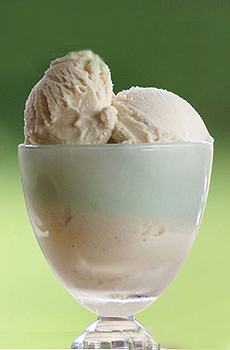
 The U.S. dairy industry produces more than 1.6 billion gallons of ice cream a year, according to the International Dairy Foods Association. Americans eat 48 billion scoops of ice cream a year—$20 billion worth. Photo courtesy Carmela Ice Cream. The U.S. dairy industry produces more than 1.6 billion gallons of ice cream a year, according to the International Dairy Foods Association. Americans eat 48 billion scoops of ice cream a year—$20 billion worth. Photo courtesy Carmela Ice Cream.
July 2006
Last Updated July 2017
|
 |
The History Of Ice Cream & The Ice Cream Cone
Plus The Sundae, Ice Cream Sodas, Frozen Custard & Frozen Novelties
Page 1: Ancient China Invents Frozen Desserts
This is Page 1 of an eight-page article on the history of ice cream. Click on the black links below to visit other pages.
2000 B.C.E.: An Ancient Treat
It’s logical to think of ice cream as a modern food because freezing technology is relatively recent. But mankind has been enjoying ice cream for thousands of years: up to 4,000 years ago, the Chinese elite enjoyed a frozen dessert. The earliest may have been a frozen syrup. According to Maguelonne Toussaint-Samat in her History of Food, “They poured a mixture of snow and saltpeter over the exteriors of containers filled with syrup, for, in the same way as salt raises the boiling-point of water, it lowers the freezing-point to below zero.”[1] Another variation was made with milk, overcooked rice and spices, packed in snow to harden. Fruit ices were also developed, prepared with fruit juices, honey and aromatic spices. Through trade routes, frozen desserts were introduced to the Persians about 2,500 years ago. (The Persian Empire includes the countries now known as Iran, Afghanistan, Azerbaijan, Turkey and portions of western China and northern Iraq.)
-
The Persians drank syrups cooled with snow called sharbat (“fruit ice” in Arabic, and the derivation of sherbet, sorbet and sorbetto); the Greek Alexander the Great, who battled the Persians for 10 years before finally toppling the Persian Empire in 330 B.C.E., enjoyed fruit “ices” sweetened with honey and chilled with snow. Three centuries later, Emperor Nero’s famous banquets always included fruit juices mixed with honey and snow.
-
Around 400 B.C.E., the Persians also invented a dessert made of rosewater and vermicelli that was a cross between a sorbet and a rice pudding called faludeh. The ice was mixed with saffron, fruits and other flavors. Today, rosewater, lemons and angel hair-thin wheat noodles are still made into a sorbet, which is a favorite dessert and party food.
-
Sorbetti and pasta arrived in Italy with the Arab invasions of Sicily in the 8th century (the Marco Polo story is a myth—see the history of pasta). Italian granita was born, flavored with fresh citrus, a wide range of fruits and coffee.
[1] Maguelonne Toussaint-Samat, History of Food, translated by Anthea Bell, Barnes & Noble Books: New York, 1992 (pp. 749-50). Continue To Page 2: The Renaissance Gives Birth To Ice Cream
Go To The Article Index Above
Lifestyle Direct, Inc. All rights reserved. Images are the copyright of their respective owners.

|




 The U.S. dairy industry produces more than 1.6 billion gallons of ice cream a year, according to the International Dairy Foods Association. Americans eat 48 billion scoops of ice cream a year—$20 billion worth. Photo courtesy Carmela Ice Cream.
The U.S. dairy industry produces more than 1.6 billion gallons of ice cream a year, according to the International Dairy Foods Association. Americans eat 48 billion scoops of ice cream a year—$20 billion worth. Photo courtesy Carmela Ice Cream.